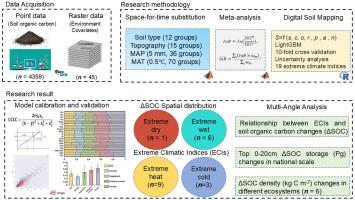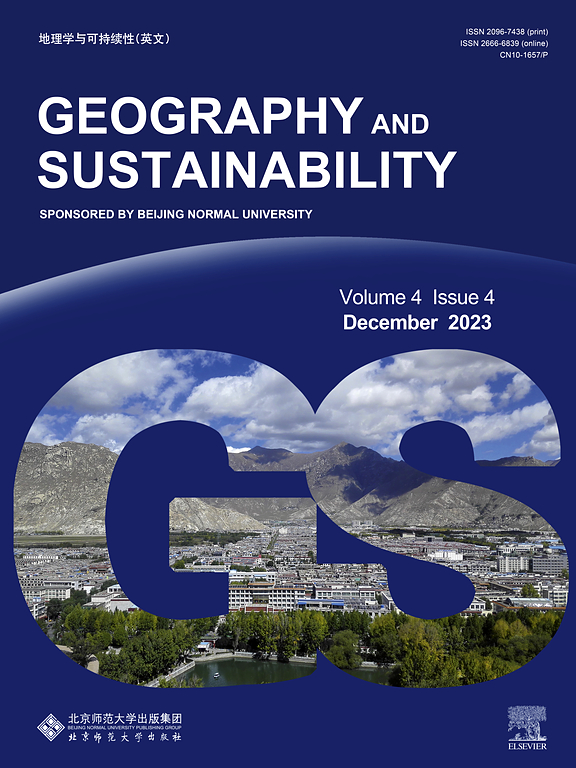The impact of extreme climate on soil organic carbon in China
IF 8
1区 环境科学与生态学
Q1 GEOGRAPHY, PHYSICAL
引用次数: 0
Abstract
Quantitative studies on the national-scale effects of extreme climatic events on soil organic carbon (SOC) remain scarce, thus limiting our understanding of SOC dynamics. This study utilized 4515 publicly available soil samples to quantify the impacts of 19 extreme climatic indices (ECIs) on ΔSOC reservoirs in China through a hybrid space-for-time and meta-analysis approach. Overall, 16/19 ECIs were negatively correlated with ΔSOC, with the minimum temperature of the coldest night (TNn) showing the strongest negative correlation. Notably, topographic factors played a pivotal role in the modeling process, contributing an average of 25 %, followed by ECIs. Under the influence of the ECIs, SOC exhibited spatial variation. Extreme heat resulted in the greatest SOC losses in cold regions, such as North China, with average reductions of > 5 %, whereas its impact was weaker in South China, with SOC losses of ∼3 %. Extreme cold and wet indices promoted SOC accumulation in the Northeast China, with increases of ∼3 %, but showed a weaker response in the humid region, where the SOC increased by only 1 %. At the national scale, the impacts of extreme climatic events on SOC in the 0–20 cm ranged from −2.36 Pg to 2.34 Pg. Different ecosystems responded variably, with forest and grassland ecosystems being more sensitive to ECIs, potentially due to higher organic matter inputs and greater ecosystem complexity. In contrast, bare land exhibited weaker responses due to limited vegetation cover and organic inputs. These findings provide valuable insights into SOC dynamics at national scale during extreme climatic events.

极端气候对中国土壤有机碳的影响
极端气候事件对土壤有机碳(SOC)影响的定量研究仍然很少,因此限制了我们对土壤有机碳动态的认识。本研究利用4515个公开土壤样本,采用时空混合和元分析的方法,量化了19个极端气候指数(ECIs)对中国ΔSOC水库的影响。总体而言,16/19 eci与ΔSOC呈负相关,其中最冷夜最低温度(TNn)负相关最强。值得注意的是,地形因素在建模过程中发挥了关键作用,平均贡献了25%,其次是eci。在eci的影响下,土壤有机碳呈现空间差异。极端高温导致中国北方等寒冷地区的有机碳损失最大,平均减少5%,而中国南方的影响较弱,有机碳损失约为3%。极端寒冷和潮湿指数促进了东北地区有机碳的积累,增加了约3%,但在潮湿地区表现出较弱的响应,其有机碳仅增加了1%。在全国范围内,极端气候事件对0 ~ 20 cm土壤有机碳的影响范围为- 2.36 ~ 2.34 Pg。不同生态系统对eci的响应差异较大,森林和草地生态系统对eci更为敏感,这可能是由于更高的有机质投入和更大的生态系统复杂性。相比之下,由于植被覆盖和有机投入有限,裸地表现出较弱的响应。这些发现为研究极端气候事件期间全国范围内的有机碳动态提供了有价值的见解。
本文章由计算机程序翻译,如有差异,请以英文原文为准。
求助全文
约1分钟内获得全文
求助全文
来源期刊

Geography and Sustainability
Social Sciences-Geography, Planning and Development
CiteScore
16.70
自引率
3.10%
发文量
32
审稿时长
41 days
期刊介绍:
Geography and Sustainability serves as a central hub for interdisciplinary research and education aimed at promoting sustainable development from an integrated geography perspective. By bridging natural and human sciences, the journal fosters broader analysis and innovative thinking on global and regional sustainability issues.
Geography and Sustainability welcomes original, high-quality research articles, review articles, short communications, technical comments, perspective articles and editorials on the following themes:
Geographical Processes: Interactions with and between water, soil, atmosphere and the biosphere and their spatio-temporal variations;
Human-Environmental Systems: Interactions between humans and the environment, resilience of socio-ecological systems and vulnerability;
Ecosystem Services and Human Wellbeing: Ecosystem structure, processes, services and their linkages with human wellbeing;
Sustainable Development: Theory, practice and critical challenges in sustainable development.
 求助内容:
求助内容: 应助结果提醒方式:
应助结果提醒方式:


